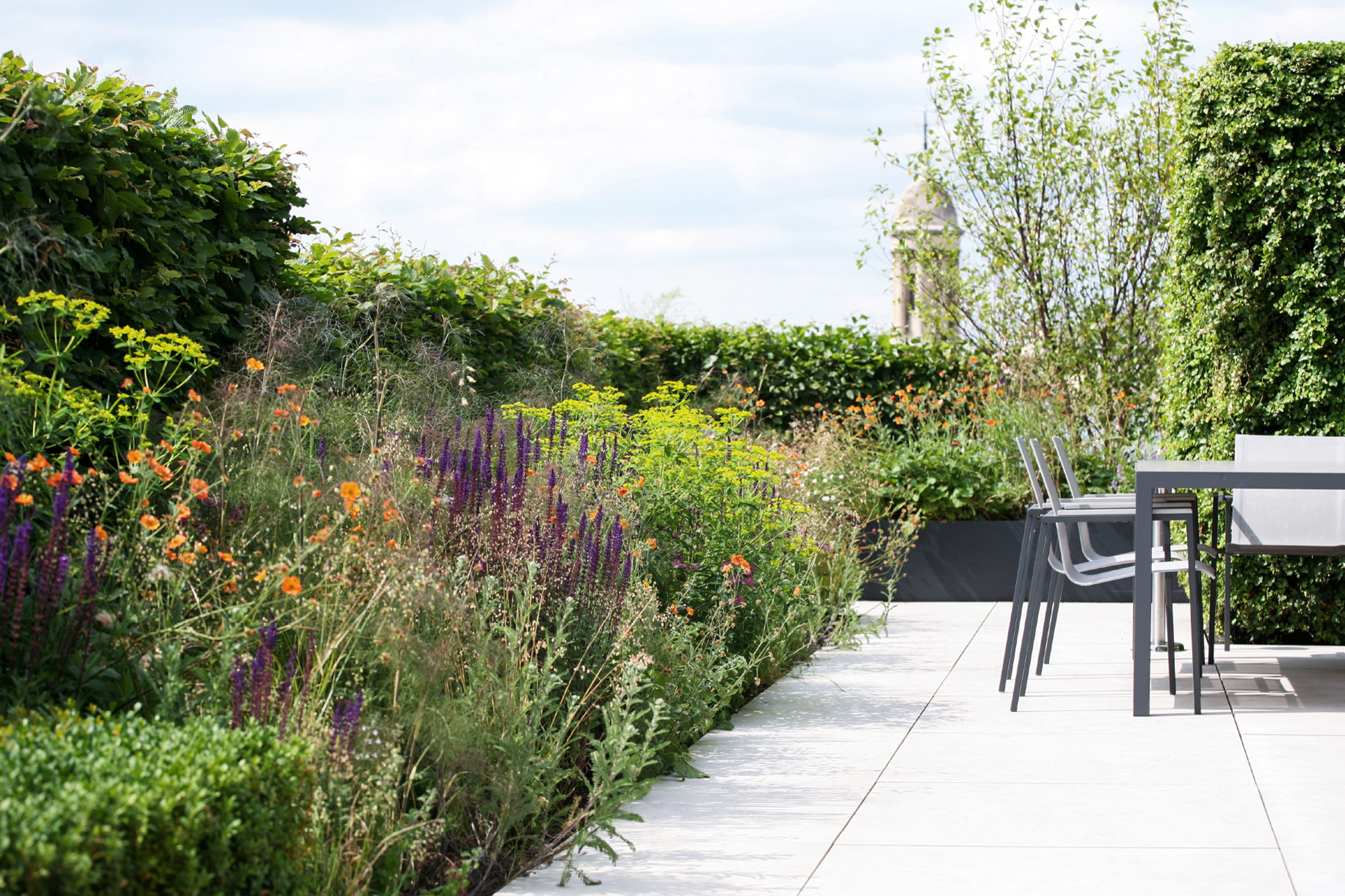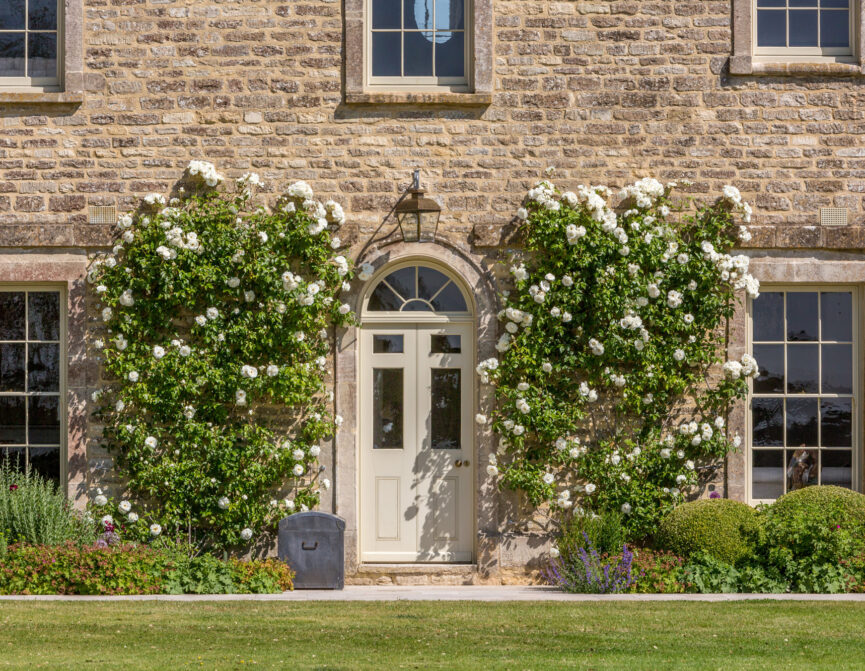Is gardening your next interiors project? On maximising outdoor spaces big and small, and the mood-boosting benefits of digging in.
Biophilic design is having its moment in the sun – or out of it, as the case may be. Incorporating raw materials, earthy colour palettes, plants and free-flowing space in our interiors, many of us are harnessing elements of nature to create a mood-boosting atmosphere. But what’s perhaps more interesting is that the trend is a two-way street. Concepts such as style, comfort and solace once associated almost exclusively with the indoors are also creeping across our gardens, rooftops and terraces. We want an outdoor sanctuary.
After months spent largely indoors, it’s not surprising we’re nurturing these feelings. There’s sunshine on the horizon. The grass is looking greener. “People will draw more pleasure from outdoor space than they did pre-pandemic,” says Marcus Barnett, a landscape designer and lecturer who specialises in uniting architectural practice and naturalism. He continues: “But they will also seek to become one with the outdoor space and be more in more invested in its design, what they can do with it and what they can get from it.”
It’s a sentiment shared by landscape architect Tom Massey, who sees an interest in the outdoors as one of the positives to come out of lockdown. “The mental and physical health benefits of gardening and spending time outside really are starting to be appreciated,” he reflects. Tom is no stranger to using garden design for the greater good. He put the spotlight on climate change with The Hothouse project for the 2020 London Design Festival; in 2018 his display on the Main Avenue at RHS Chelsea Flower Show was designed to improve the lives of refugees in Iraqi Kurdistan; and, notably, in 2017 his garden at RHS Hampton Court explored the powerful effect of plants on mood and wellbeing.
The process of cultivating an outdoor space can itself be therapeutic. That’s why landscape designer Emily Erlam – whose approach is guided by environmental sensitivity – believes that gardening chimes well with a desire to replace commercialism with more introspective forms of gratification. “We are looking inside ourselves for new, more simple ways to find pleasure,” she explains. “Gardening, or even just being in a garden, is a lovely hobby and it’s rewarding to see change as seasons pass. A good garden can also attract wildlife, which is so satisfying.”
The gardens of tomorrow will be designed to enhance these refreshed ideals. For Marcus, “the concept of the home being purely internal and the garden external is being diluted”. And as the line between inside and out blurs, our relationship with the environment will only get stronger. For a more seamless transition, Tom suggests large picture windows or garden doors that open with a flush threshold. Using similar materials or decor inside and out enhances the visual link.
“With all of my design, I try to draw people outside,” Tom explains. That could mean placing a seating area near the back of the garden to draw people through the space. Engaging the senses with a thoughtful use of fragrance and colour. Creating screens or visual barriers is also an effective way to invite exploration. “Gardens are much more interesting if they are revealed slowly as you explore,” he adds, reflecting on one of his residential projects in east London that incorporated Crittall doors and a winding path. Some supposedly indoor activities can be moved outside, too, he thinks. “Dining areas, whether formal or informal, give another reason to get out and use the garden. Many people now want an outdoor kitchen or area for a pizza oven or barbecue.”
Gardens are much more interesting if they are revealed slowly as you explore.
- Tom Massey


Of course, urban residential planning doesn’t often cater to spacious gardens. It’s in this context that intelligent garden design blossoms, maximising each square foot of smaller plots. Thinking vertically is often a good option – living walls, plant shelves and hanging baskets add green without taking up any floor space. When planning, it’s worth evaluating what you want from your garden, be it an area for outdoor entertaining or a vegetable patch. “Start with your priorities, then if you have space, work down your list and add other elements,” Tom recommends, drawing on years of experience. “Clever detailing is also important. Integrated or built-in furniture can save space while bespoke storage solutions make use of awkward footprints or otherwise unusable areas.”
No matter the size of your outdoor space, it’s easy to be lead down the garden path by overambitious design ideas. Keep in mind what is achievable and sustainable. “Don’t burden yourself with too much commitment in terms of maintaining your ideas,” advises Marcus. Likewise, Emily recommends practising self-constraint to succeed: “Only choose plants that will be happy with the amount of light and water you can offer. Also consider wind resistance, as some balconies and roof terraces provide quite punishing conditions.” For inspiration, turn to the roof terrace of the Plimsoll Building in King’s Cross, which Emily designed in 2014. Sturdy steel planters filled with sculptural, hardy botanicals – including billowing evergreens, fragrant rosemary, soft Pennisetum – zone and protect dining areas, while giving a vibrant green fringe to the city skyline.
As our collective focus is drawn by the power of nature, landscape designers are becoming architects of the outdoors, creating gardens that strike a balance between practicality, aesthetics and wellbeing. These aren’t simply places but experiences. And more than a discrete add-on, gardens of the future will be an extension of the home.












